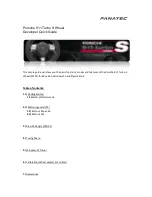
Tyre pressure monitoring system (TPMS)*
Starting and driving 6-119
6
Each tyre, including the spare, should be
checked monthly when cold and inflated to
the inflation pressure recommended by the
vehicle manufacturer on the tyre inflation
pressure label. (If your vehicle has tyres of a
different size than the size indicated on the
tyre inflation pressure label, you should
determine the proper tyre inflation pressure
for those tyres.)
As an added safety feature, your vehicle has
been equipped with the tyre pressure monitor-
ing system (TPMS) that illuminates a low
tyre pressure telltale when one or more of
your tyres is significantly under-inflated.
Accordingly, when the low tyre pressure tell-
tale illuminates, you should stop and check
your tyres as soon as possible, and inflate
them to the proper pressure. Driving on a sig-
nificantly under-inflated tyre causes the tyre
to overheat and can lead to tyre failure.
Under-inflation also reduces fuel efficiency
and tyre tread life, and may affect the vehi-
cle’s handling and stopping ability.
Please note that the tyre pressure monitoring
system (TPMS) is not a substitute for proper
tyre maintenance, and it is the driver’s
responsibility to maintain correct tyre pres-
sure, even if under-inflation has not reached
the level to trigger illumination of the tyre
pressure monitoring system (TPMS) low tyre
pressure telltale.
Your vehicle has also been equipped with the
warning lamp to indicate when the system is
not operating properly.
The warning lamp is combined with the low
tyre pressure telltale.
When the system detects a malfunction, the
telltale will flash for approximately 1 minute
and then remain continuously illuminated.
This sequence will continue upon subsequent
vehicle start-ups as long as the malfunction
exists.
When the warning lamp is illuminated, the
system may not be able to detect or signal
low tyre pressure as intended.
The tyre pressure monitoring system (TPMS)
malfunctions may occur for a variety of rea-
sons, including the installation of replace-
ment or alternate tyres or wheels on the
vehicle that prevent the tyre pressure moni-
toring system (TPMS) from functioning prop-
erly. Always check the tyre pressure
monitoring system (TPMS) malfunction tell-
tale after replacing one or more tyres or
wheels on your vehicle to ensure that the
replacement or alternate tyres and wheels
allow the tyre pressure monitoring system
(TPMS) to continue to function properly.
E00637300170
1. If the warning lamp illuminates, avoid
hard braking, sharp steering maneuvers
and high speeds. You should stop and
adjust the tyres to the proper inflation
pressure as soon as possible. Adjust the
spare tyre at the same time. Refer to
“Tyres” on page 10-13.
NOTE
In addition, the warning display is displayed
on the information screen in the multi-infor-
mation display.
If the warning lamp/display
illuminates while driving
NOTE
In addition, the warning display is displayed
on the information screen in the multi-infor-
mation display.
When inspecting or adjusting the tyre pres-
sure, do not apply excessive force to the
valve stem to avoid breakage.
After inspecting or adjusting the tyre pres-
sure, always reinstall the valve cap on the
valve stem.
Without the valve cap, dirt or moisture could
get into the valve, resulting in damage to the
tyre inflation pressure sensor.
BK0240501EN.book 119 ページ 2016年11月10日 木曜日 午前10時35分
Summary of Contents for SHOGUN SPORT
Page 1: ...SHOGUN SPORT OWNER S MANUAL SHOGUN SPORT EN UK 17MY OKWE17E1...
Page 172: ......
Page 492: ...BK0240501EN book 9...
Page 493: ...Certification BK0240501EN book 1...
Page 494: ...g j j g BK0240501EN book 2...
Page 495: ...C C A y C C c j j C A BK0240501EN book 3...
Page 497: ...BK0240501EN book 5...
Page 498: ...BK0240501EN book 6...
Page 499: ...BK0240501EN book 7...
Page 500: ...BK0240501EN book 8...
Page 501: ...BK0240501EN book 9...
















































